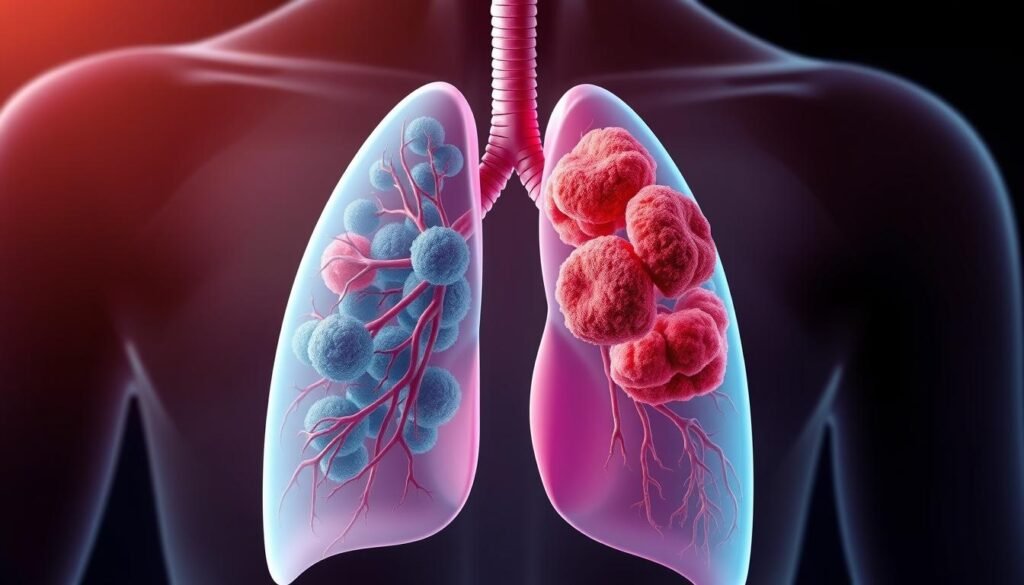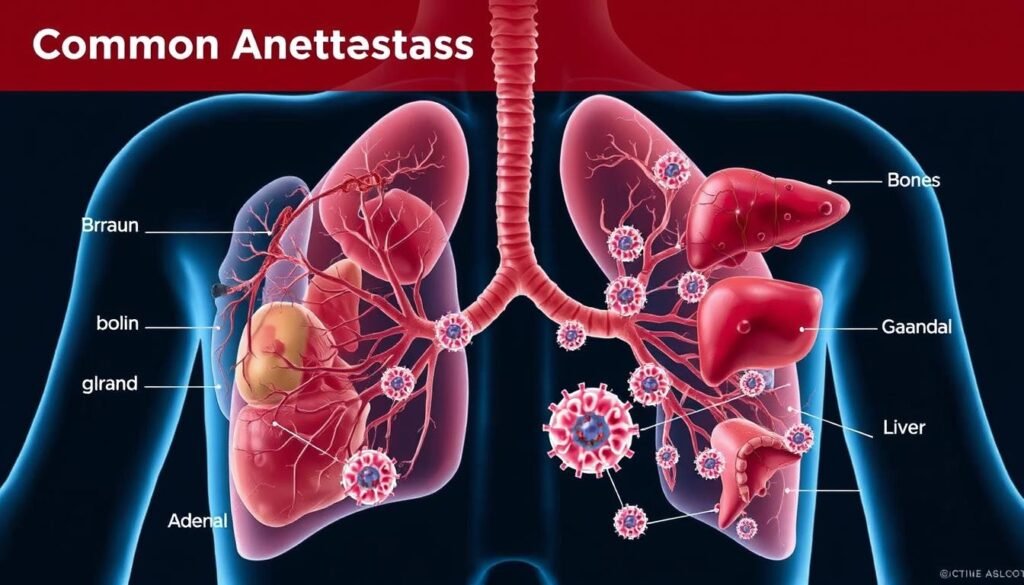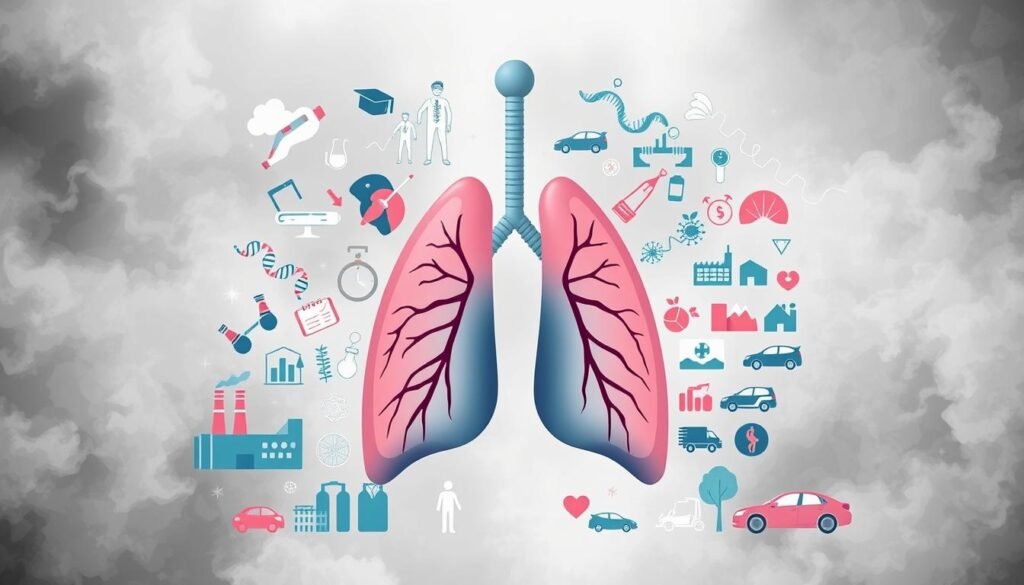Lung cancer starts from small, harmless cells and can grow into a dangerous tumor over years. It usually requires a lung cancer cell to divide 30 times to be seen on an x-ray. Early detection and understanding how lung cancer progresses is vital.
About 238,340 new lung cancer cases are expected in the United States in 2023. Of these, 10-15% are small-cell lung cancer (SCLC). It’s crucial to know how fast lung cancer can spread.
This article offers a deep look into lung cancer. It covers types, stages, and how quickly it can progress. It also covers what factors affect how fast it spreads. This information helps readers understand this serious issue.
Key Takeaways
- Lung cancer progression typically spans multiple years.
- Understanding the stages of lung cancer progression is crucial for early intervention.
- Timely detection can significantly impact survival rates.
- Small-cell lung cancer often metastasizes quickly, with 70% of cases spreading at diagnosis.
- Median survival for limited-stage SCLC varies dramatically compared to extensive-stage SCLC.
- Monitoring early symptoms can facilitate prompt diagnosis and treatment.
Understanding Lung Cancer
Lung cancer starts in the lungs, which we need for breathing and getting nutrients. It’s key to understand lung cancer to see how it affects health. There are two main types: small cell lung cancer (SCLC) and non-small cell lung cancer (NSCLC). Most people, 80-85%, get diagnosed with NSCLC in the U.S. SCLC, making up 15-20%, is less common.
SCLC spreads quickly, more so than NSCLC. Many lung cancers don’t show symptoms early on. That’s why early screenings and knowing the risks, like smoking and toxin exposure, are so important.
The treatment for lung cancer depends on the kind and stage of the cancer. Surgeons can remove early-stage tumors. Other treatments like chemotherapy, radiation, and targeted drugs might be needed too. Knowing about lung cancer helps in finding treatments and stresses the importance of looking after our health.
The Types of Lung Cancer
Lung cancer comes in two main types: small cell (SCLC) and non-small cell (NSCLC).
NSCLC accounts for about 80% to 85% of all lung cancer cases. This category includes adenocarcinoma, common among non-smokers and the younger crowd. Another kind, squamous cell carcinoma, often connects to a smoking history.
SCLC makes up 10% to 15% of lung cancers. It grows and spreads fast, usually found at a late stage. This makes treatment tough. But NSCLC, which includes adenocarcinoma and squamous cell carcinoma, progresses slower. This allows for more treatment options.
Then, there are rare cancers like carcinoid tumors and mesothelioma. Carcinoid tumors are slow growers, less than 5% of lung tumors. Mesothelioma, tied to asbestos exposure, is about 5% of cases. It usually shows up 30 to 50 years after exposure.
Knowing these lung cancer types helps in planning the best treatment. For example, adenocarcinomas grow slower than squamous cell tumors. This means the treatment strategy could differ.
| Type of Lung Cancer | Percentage of Cases | Characteristics |
|---|---|---|
| Non-Small Cell Lung Cancer (NSCLC) | 80% to 85% | Slower growth; includes adenocarcinoma and squamous cell carcinoma. |
| Small Cell Lung Cancer (SCLC) | 10% to 15% | Rapid growth; typically diagnosed at advanced stages. |
| Mesothelioma | About 5% | Linked to asbestos exposure; develops much later. |
| Carcinoid Tumors | Less than 5% | Rare; generally slow-growing. |
Stages of Lung Cancer Progression
Lung cancer staging is crucial for choosing treatments and predicting outcomes. It ranges from stage 0 to stage 4. At stage 0, the cancer is just in one spot and can be treated well. When the cancer gets to stage I, it grows but stays in the lung.
By stages II and III, the cancer grows more and may reach nearby lymph nodes. These stages show how the cancer is spreading.
Stage IV lung cancer is very challenging because it spreads to other parts of the body. This reduces the chances of surviving the disease, making it important to find it early. Sadly, around 53% of lung cancers are already spread when found.
The TNM system classifies lung cancer by tumor size (T), lymph node involvement (N), and metastasis (M). This system is detailed for non-small cell lung cancer (NSCLC) and small cell lung cancer (SCLC). About 85% of lung cancer cases are NSCLC, with SCLC making up 10% to 15%.
Knowing how lung cancer stages work is key for patients and doctors. Here’s a simple table of the stages:
| Stage | Description |
|---|---|
| Stage 0 | In situ cancer; confined to the layer of cells where it started |
| Stage I | Early-stage cancer; localized and small in size |
| Stage II | More extensive growth; may involve nearby lymph nodes |
| Stage III | Advanced local disease; significant tumor growth and lymph node involvement |
| Stage IV | Metastasized; cancer has spread to distant organs |
For more details on lung cancer progression, check out this link. Understanding these stages helps manage patients better and improve treatment success.
How Long Does It Take Lung Cancer to Spread
The path lung cancer takes from its start to spreading is different for everyone. It involves many steps and factors that change how fast it spreads. Knowing about this can help us understand why catching lung cancer early is key.
Overview of Metastasis
Metastasis means cancer moves from its original spot to other body parts. For lung cancer, this happens through blood or lymphatic systems. Lung cancer usually takes three to six months to double in size. This shows us how quickly it can grow.
Non-small cell lung cancer (NSCLC) makes up about 85% of cases and spreads at different speeds. Then there’s small cell lung cancer (SCLC), which is 10% to 15% of cases. It spreads fast, with 70% of patients having cancer that has already spread at diagnosis.
Average Timeframes for Different Types
Lung cancer spreading times vary. SCLC often starts to spread within weeks after finding out you have it. NSCLC, like adenocarcinomas, can stay mostly the same for years. This makes treating it tricky. For example:
- Squamous cell carcinoma might take about eight years to get big, which can mean finding it late.
- On the other hand, SCLC spreads fast and needs quick action.
No matter the cancer type, it’s hard because most lung cancers aren’t found until they’re far along. This shows how crucial it is to know about lung cancer and get checked regularly.
Lung Cancer Metastasis Timeline
The lung cancer metastasis timeline is key for understanding how and where this cancer spreads. It depends on lung cancer type, genetic mutations, and patient’s health. These factors impact how fast the cancer grows.
Factors Affecting Metastasis Time
Several factors affecting lung cancer spread influence its speed. Key factors include:
- Tumor Type: Small cell lung cancer spreads quickly due to its aggressiveness. Non-small cell lung cancer grows slower, taking time to show symptoms.
- Genetic Mutations: Some gene abnormalities increase the speed of cancer spread, especially in aggressive cancers.
- Patient Lifestyle: Smoking, diet, and health overall can affect cancer spreading rate.
Aggressive vs. Non-Aggressive Types
Knowing the difference between aggressive and less aggressive lung cancers is vital for treatment. For example:
| Cancer Type | Stage | Survival Rate |
|---|---|---|
| Non-Small Cell Lung Cancer (NSCLC) | Stage 4 Metastatic | 8% |
| NSCLC Regional Spread | Stage 4 | 37% |
| Small Cell Lung Cancer (SCLC) | Stage 4 Widespread | 3% |
| SCLC Regional Spread | Stage 4 | 18% |
Understanding these differences helps create better monitoring and treatment plans. By looking at the metastatic process and patient factors, healthcare teams can design effective treatments.
Growth Rate of Lung Tumors
The growth of lung tumors deeply impacts treatment choices and survival rates. The key metric here is tumor doubling time. This measures how long it takes for a tumor to double in size. Different types of lung cancer grow at different rates. For example, small-cell lung cancer (SCLC) grows quickly. It makes up about 10–15% of all lung cancer cases. SCLC tumors’ doubling time is roughly 86 days, but it can range from 25 to 217 days. This fast growth allows the cancer to spread quickly through the body.
Non-small cell lung cancer (NSCLC) shows a broader range of growth. The doubling time for these tumors is between 134 to 647 days. Many things affect the growth rate of lung tumors. These include the cancer’s subtype, whether the patient smokes, and their overall health. Adenocarcinoma, the most common lung cancer in the U.S., tends to grow slower. This often gives doctors more time to treat it.
Statistics highlight the growth differences between lung cancer types. Around 70% of SCLC patients have cancer that has spread at diagnosis. This generally leads to worse treatment results. In contrast, slower-growing tumors tend to respond better to initial treatments. This can greatly improve a patient’s chances of survival.
Knowing the various growth rates and doubling times of lung cancer is key. It helps doctors create personalized treatment plans for each patient.

Early Symptoms of Spreading Lung Cancer
It’s vital to recognize early signs of spreading lung cancer. Often, people ignore these symptoms, thinking they’re due to colds or stress. Realizing these symptoms early can help choose better treatments. They become more noticeable as the disease grows.
Common Signs to Watch For
As lung cancer progresses, different symptoms might appear. Spotting these signs early is essential. Doing so can make treatment more successful. Look out for these common indicators:
- Persistent Cough: A cough that stays might mean something more serious is happening.
- Chest Pain: Pain in the chest area could be a sign that cancer is spreading.
- Shortness of Breath: When breathing gets hard, it could mean the cancer is growing.
- Unexplained Weight Loss: Losing weight without trying might warn of cancer.
- Coughing up Blood: If blood comes up when coughing, it’s crucial to see a doctor fast.
- Fatigue: Feeling very tired all the time can be linked to cancer getting worse.
- New Onset of Wheezing: Wheezing when breathing might show a lung problem.
Other signs include a hoarse voice, frequent infections, and even brain effects as cancer reaches further. Knowing these symptoms helps people get medical help early. Early help can lead to better treatment chances.
Where Does Lung Cancer Spread?
Lung cancer doesn’t stay just in the lungs. It tends to spread to other body parts as it grows. Knowing where lung cancer spreads helps with getting the right treatment early. Recognizing the common sites of metastasis is key in handling this illness.
Common Sites of Metastasis
Lung cancer mainly spreads to a few specific places, including:
- Brain: About 40% of lung cancer patients will have it spread to their brain.
- Bones: 30% to 40% of those with advanced lung cancer see it spread to bones.
- Liver: The liver is impacted in 30% to 50% of advanced-stage lung cancer cases.
- Adrenal glands: These glands also often get affected by the spread.
- Lymph nodes: Cancer often moves to nearby lymph nodes before spreading farther.
As cancer cells grow, they are more likely to spread. This includes both close by and distant areas. Catching it early and knowing these lung cancer spread locations makes treating the disease easier.

| Site of Metastasis | Percentage of Affected Patients |
|---|---|
| Brain | 40% |
| Bones | 30% – 40% |
| Liver | 30% – 50% |
| Adrenal Glands | Variable |
| Lymph Nodes | Commonly Invaded |
Understanding how lung cancer spreads is vital for doctors and patients. It guides in planning treatments and dealing with the tough emotions after an advanced cancer diagnosis.
Lung Cancer Survival Rates and Prognosis
Lung cancer survival rates are affected by the type and stage of cancer at diagnosis. For non-small cell lung cancer (NSCLC), the five-year statistics are quite sobering. When the cancer is localized, about 65% of patients live for five years or more.
However, as the cancer progresses, these rates drop significantly. For stage 2, the survival rate falls to around 40%. By stage 3, it decreases further to about 15%. And for stage 4, the survival rate plummets to just 5%.
Early detection plays a critical role in improving lung cancer prognoses. Using CT scans helps identify cancer early in those at high risk. On average, about 26.7% of patients live for five years after their diagnosis. In England, the statistics are similar, with 20% of patients living for five years.
Small cell lung cancer (SCLC) has different outcomes. For SCLC, 30% survive in localized cases. This drops to 18% for regional spread, and only 3% for distant stages. It shows how crucial early treatment and regular checks are for lung health.
Factors Affecting Lung Cancer Spread
It’s important to know the factors that affect how lung cancer spreads. Both our genes and our lifestyles play big roles. They help decide how fast lung cancer moves through our body.
Genetic Factors and Their Impact
Genes can really change how lung cancer acts and how fast it spreads. For example, changes in the EGFR gene can make tumors grow quicker. It’s found that lung cancer can grow double its size in about four to five months. Knowing this helps doctors figure out the best treatment.
Not every tumor grows at the same speed. Research found that non-small cell lung cancer (NSCLC) tumors take an average of 191 days to double. Small cell lung cancers grow faster, especially in the extensive stage, doubling in just 24 days. Understanding these gene-related differences helps doctors give personalized treatments.
Influence of Lifestyle Choices
Choices we make, like smoking, greatly impact how lung cancer spreads. Smoking is the top cause of lung cancer and makes it spread faster. Stats show that by the time lung cancer is found, 53% of cases have spread, especially small cell lung cancers.
Making healthier life choices can lower some lung cancer risks. Knowing and teaching about these choices can prevent lung cancer. For more information on lung cancer and new treatments, check this resource.

| Type of Lung Cancer | Average Doubling Time (Days) | Growth Rate Category |
|---|---|---|
| Small Cell Lung Cancer | 24 (extensive stage) | Rapid Growing |
| Small Cell Lung Cancer | 97.6 (limited stage) | Moderate Growing |
| Non-Small Cell Lung Cancer | 191 | Moderate Growing |
| Squamous Cell Carcinoma | Less than 183 | Rapid Growing |
| Lung Adenocarcinoma | Over 365 | Slow Growing |
Conclusion
It’s really important to understand lung cancer’s growth to manage it well. This article talked about the need to know the different types, stages, and signs of lung cancer. These factors are key in figuring out how to treat patients.
Small cell lung cancer (SCLC) is very aggressive and grows quickly. This raises big challenges due to its fast spread and low survival rates. Detecting lung cancer early and doing screenings often can’t be overlooked in fighting this disease.
Moreover, knowing what treatments are available aids patients and caregivers in handling lung cancer’s complexity. Being aware of early signs, like ongoing coughs, breathing trouble, and tiredness, leads to quick doctor visits. It’s crucial for patients and healthcare providers to talk well about lung cancer concerns.
To wrap up, finding lung cancer early and doing regular screenings can really change the outcome. For those interested in more about early signs, check out knowing lung cancer symptoms. By focusing on these discussions and finding the best treatment plans, people can increase their chances of handling this tough disease better.